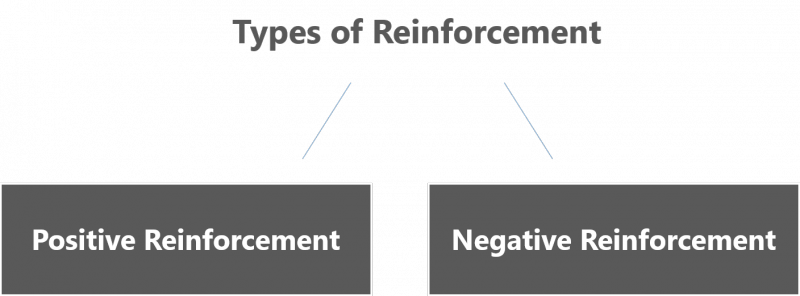Reinforcement is:
an evidence-based practice used to teach target skills and increase desired behavior.
a foundational practice underpinning most other evidence-based practices (e.g., prompting, pivotal response training, activity systems) for toddlers with autism spectrum disorder (ASD).
the relationship between the toddler’s behavior or use of a skill and the consequence of that skill or behavior. The relationship between behavior or use of skill and consequence is only reinforcing if that consequence increases the likelihood that the toddler performs the skill or behavior. An example would be a toddler being taught to request objects such as toys will only request if the toy is one that he desires.
There are two types of reinforcement:
Positive Reinforcement
Negative Reinforcement
Positive reinforcement (giving something the toddler wants) is the delivery of a reinforcer (primary such as food and comfort or secondary such as verbal praise, toys, or preferred activities) after the toddler does the target skill or behavior.
Negative reinforcement (taking away something the toddler doesn’t want) is the removal of an object or activity that the toddler does not like (e.g., staying at the table at dinner) when the toddler does the identified behavior or skill.
Introduction to positive reinforcement
Positive reinforcement is at work when consequences that follow a skill or behavior result in an increase in that skill or behavior by the toddler.
EXAMPLE
When dumping shapes in a shape sorter results in well-loved tickles the toddler is even more likely to continue using the shape sorter. Another toddler may be reinforced to allow his shoes to be put on by mom if this activity is directly followed by outside play.
PRINCIPLES OF POSITIVE REINFORCEMENT
To ensure better success, the following core principles of reinforcement, should be kept in mind as you implement the practice.
1. Reinforcement must be meaningful to the toddler. If the reinforcer chosen holds no value to the child it is very unlikely to affect her behavior. For example, while many toddlers are reinforced by social attention and physical affection, some children with autism spectrum disorders may find these aversive. For these toddlers, social praise and physical affection is unlikely to elicit increases in skill/behavior. Conducting a reinforcement sampling better ensures that reinforcers are individualized.
2. As possible, reinforcers should be natural and related to the skill or behavior. Natural reinforcers are those that would have occurred anyway if the toddler engaged in the skill/behavior. When teaching a toddler to request, the toddler’s requests should, as possible, be immediately followed by a related response to each request.
3. Multiple reinforcers are more effective than a single reinforcer (Alberto & Troutman, 2008). Pairing reinforcers helps to increase value for the toddler. A toddler, who enjoys mom’s attention, will be more likely to consistently sign for “help” by getting help from mom along with her smile and a cheerful “yay”.
4. Recognize and plan for the potential of satiation. When the reinforcer is overused it may lose value for the toddler. A toddler may not be interested in learning to put pieces in a puzzle if after every piece placed in the puzzle he gets a fuzzy ball to play with before returning to the puzzle. He may enjoy the activity and be more likely to place the pieces if the reinforcer is provided after the entire puzzle is completed. Additionally, a toddler may not find value in completing a cleanup routine if he is being reinforced by crackers just after his lunch. More information on the importance of schedules for reinforcement follows.
Introduction to Negative reinforcement
Negative reinforcement is the removal of an unpleasant event when the toddler engages in the behavior or skill. Like positive reinforcement, negative reinforcement leads to an increase in the toddler’s use of the skill or behavior.
EXAMPLE
A dad provides negative reinforcement when he removes the lunch plate when his son says “all done.”
Mom is negatively reinforced when her daughter stops screaming in the checkout line after mom gives her the desired candy.
PRINCIPLES OF NEGATIVE REINFORCEMENT
1. Negative reinforcement is NOT punishment. Punishment is meant to decrease behavior while negative reinforcement is meant to increase behavior by taking away the aversive/unpleasant event.
2. Negative reinforcement is generally used to teach a target skill or behavior to take the place of an interfering behavior. For example, when the toddler says “help” instead of screaming he is given the item he wanted which was being held by his mom.
3. Negative reinforcement is generally used when using positive reinforcement has been ineffective in teaching the toddler a replacement skill or behavior.
4. Since negative reinforcement is generally used to teach a replacement skill, it may lead to an increase in the challenging behavior if the negative reinforcer chosen is not of value for the toddler or the toddler doesn’t make the connection between the aversive being removed due to his use of the replacement behavior or skill.
![]()





